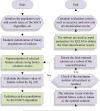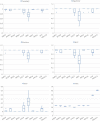A new machine learning model for predicting severity prognosis in patients with pulmonary embolism: Study protocol from Wenzhou, China
- PMID: 36590908
- PMCID: PMC9802582
- DOI: 10.3389/fninf.2022.1052868
A new machine learning model for predicting severity prognosis in patients with pulmonary embolism: Study protocol from Wenzhou, China
Abstract
Introduction: Pulmonary embolism (PE) is a common thrombotic disease and potentially deadly cardiovascular disorder. The ratio of clinical misdiagnosis and missed diagnosis of PE is very large because patients with PE are asymptomatic or non-specific.
Methods: Using the clinical data from the First Affiliated Hospital of Wenzhou Medical University (Wenzhou, China), we proposed a swarm intelligence algorithm-based kernel extreme learning machine model (SSACS-KELM) to recognize and discriminate the severity of the PE by patient's basic information and serum biomarkers. First, an enhanced method (SSACS) is presented by combining the salp swarm algorithm (SSA) with the cuckoo search (CS). Then, the SSACS algorithm is introduced into the KELM classifier to propose the SSACS-KELM model to improve the accuracy and stability of the traditional classifier.
Results: In the experiments, the benchmark optimization performance of SSACS is confirmed by comparing SSACS with five original classical methods and five high-performance improved algorithms through benchmark function experiments. Then, the overall adaptability and accuracy of the SSACS-KELM model are tested using eight public data sets. Further, to highlight the superiority of SSACS-KELM on PE datasets, this paper conducts comparison experiments with other classical classifiers, swarm intelligence algorithms, and feature selection approaches.
Discussion: The experimental results show that high D-dimer concentration, hypoalbuminemia, and other indicators are important for the diagnosis of PE. The classification results showed that the accuracy of the prediction model was 99.33%. It is expected to be a new and accurate method to distinguish the severity of PE.
Keywords: disease diagnosis; extreme learning machine; feature selection; pulmonary embolism; swarm intelligence.
Copyright © 2022 Su, Shou, Fu, Zhao, Heidari, Han, Wu, Chen and Chen.
Conflict of interest statement
The authors declare that the research was conducted in the absence of any commercial or financial relationships that could be construed as a potential conflict of interest.
Figures








References
-
- Adarsh B. R., Raghunathan T., Jayabarathi T., Yang X.-S. (2016). Economic dispatch using chaotic bat algorithm. Energy 96 666–675. 10.1016/j.energy.2015.12.096 - DOI
-
- Agterof M. J., van B. E., Schutgens R., Snijder R., Tromp E., Prins M., et al. (2009). Risk stratification of patients with pulmonary embolism based on pulse rate and D-dimer concentration. Thromb. Haemost. 102 683–687. - PubMed
-
- Aranda C., Peralta L., Gagliardi L., Lopez A., Jimenez A., Herreros B. (2021). A significant decrease in D-dimer concentration within one month of anticoagulation therapy as a predictor of both complete recanalization and risk of recurrence after initial pulmonary embolism. Thromb. Res. 202 31–35. 10.1016/j.thromres.2021.02.033 - DOI - PubMed
LinkOut - more resources
Full Text Sources
Research Materials

